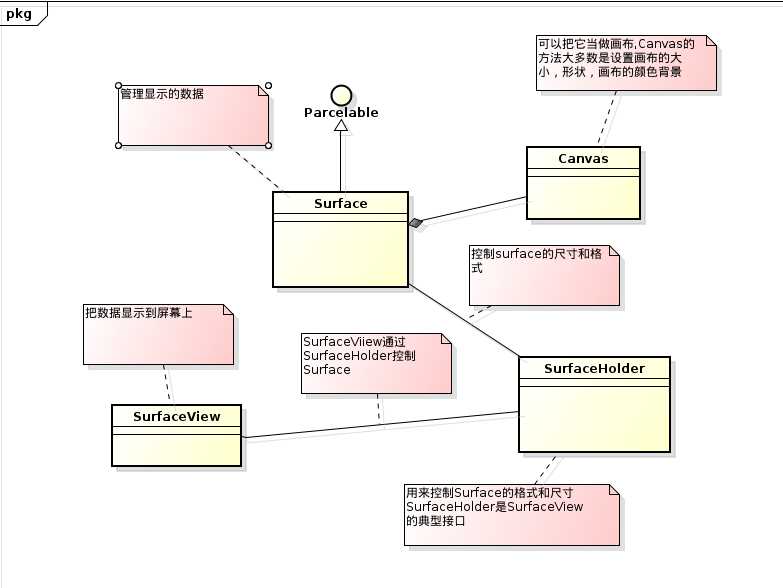标签:

1、Surface
Surfaceextends Objectimplements Parcelable
Class OverviewHandle onto a raw buffer that is being managed by the screen compositor. 简单翻译: Surface是原始图像缓冲区(raw buffer)的一个句柄,而原始图像缓冲区是由屏幕图像合成器(screen compositor)管理的。 |
||||
1.1、 就如在C语言编程一样,通过一个文件的句柄,就可以操作文件,获取文件的内容。 同样的,通过Surface就可以获取raw buffer其中的内容。原生缓冲区(raw buffer)存储着当前窗口的像素数据。
1.2、事实上,当得到一个Surface对象时,同时会得到一个Canvas(画布)对象。这一点可以通过查看\frameworks\base\core\java\android\view\Surface.java文件可知道Surface类定义了一个Canvas成员变量
1.3、 理解Canvas对象,可以把它当做画布,Canvas的方法大多数是设置画布的大小、形状、画布背景颜色等等,要想在画布上面画画,一般要与Paint对象结合使用,顾名思义,Paint就是画笔的风格,颜料的色彩之类的。
1.4、Surface本身的作用类似一个句柄,得到了这个句柄就可以得到其中的Canvas、原生缓冲器以及其它方面的内容。
1.5、Surface实现了Parcelable接口,(implements Parcelable),也就是说Surface对象可以把显示内容的数据写入到 Parcel 中,并且能够从Parcel读回数据。
Parcelable
Class OverviewInterface for classes whose instances can be written to and restored from a 实现这个接口的对象可以写入数据到Parcel,同时也可以把数据读出来。 |
2、SurfaceView
SurfaceViewextends View
Class OverviewProvides a dedicated drawing surface embedded inside of a view hierarchy. You can control the format of this surface and, if you like, its size; the SurfaceView takes care of placing the surface at the correct location on the screen The surface is Z ordered so that it is behind the window holding its SurfaceView; the SurfaceView punches a hole in its window to allow its surface to be displayed. The view hierarchy will take care of correctly compositing with the Surface any siblings of the SurfaceView that would normally appear on top of it. This can be used to place overlays such as buttons on top of the Surface, though note however that it can have an impact on performance since a full alpha-blended composite will be performed each time the Surface changes. Access to the underlying surface is provided via the SurfaceHolder interface, which can be retrieved by calling The Surface will be created for you while the SurfaceView‘s window is visible; you should implement One of the purposes of this class is to provide a surface in which a secondary thread can render into the screen. If you are going to use it this way, you need to be aware of some threading semantics:
简单翻译: SurfaceView提供了一个专门用于绘制的surface,这个surface内嵌于。你可以控制这个Surface的格式和尺寸。Surfaceview控制这个Surface在屏幕的正确绘制位置。surface是Z-ordered的(也就是说在xyz坐标系中,按照Z坐标排序的,Z值大的表面覆盖在Z值小的表面的上方),这表明它总在自己所在窗口的后面。surfaceview在显示窗口处为Surface提供了一个可见区域,通过这个区域,才能看到Surface里面的内容。可以放置一些覆盖图层(overlays)在Surface上面,如Button、Textview之类的。但是,需要注意的是,如果Surface上面有全透明的控件,那么随着Surface的每一次变化,这些全透明的控件就会重新渲染,这样的话,就影响性能与显示的效果。 你可以通过SurfaceHolder这个接口去访问Surface,而执行getHolder()方法可以得到SurfaceHolder接口。 当SurfaceView的窗口可见时,Surface就会被创建,当SurfaceView窗口隐藏时,Surface就会被销毁。当然了,你也可以通过复写 surfaceCreated(SurfaceHolder) 和 surfaceDestroyed(SurfaceHolder) 这两个方法来验证一下Surface何时被创建与何时被销毁。SurfaceView提供了一个运行在渲染线程的surface,若你要更新屏幕,你需要了解以下线程知识。
|
|||||||||||||||||||||
2.1、SurfaceView与Surface的联系
简单来说,SurfaceView与Surface的联系就是,Surface是管理显示内容的数据(implementsParcelable),包括存储于数据的交换。而SurfaceView就是把这些数据显示出来到屏幕上面。
两者联系如图所示:
3、SurfaceHolder
SurfaceHolder
Class OverviewAbstract interface to someone holding a display surface. Allows you to control the surface size and format, edit the pixels in the surface, and monitor changes to the surface. This interface is typically available through the When using this interface from a thread other than the one running its 简单翻译: 与直接控制SurfaceView来修改surface不同,使用SurfaceHolder来修改surface时,需要注意 lockCanvas() 和Callback.surfaceCreated().这两个方法。 |
SurfaceHolder控制surface的流程所使用的几个方法。
| 3.1、abstract void addCallback(SurfaceHolder.Callback callback) Add a Callback interface for this holder.// 给SurfaceHolder一个回调对象。 3.2、abstract Canvas lockCanvas(Rect dirty) Just like lockCanvas() but allows specification of a dirty rectangle. // 锁定画布中的某一个区域,返回的画布对象Canvas(当更新的内容只有一个区域时,同时要追求高效,可以只更 新一部分的区域,而不必更新全部画布区域) 3.3、abstract Canvas lockCanvas() Start editing the pixels in the surface.// 锁定画布,返回的画布对象Canvas 3.4、abstract void removeCallback(SurfaceHolder.Callback callback) Removes a previously added Callback interface from this holder.//移除回调对象 3.5、abstract void unlockCanvasAndPost(Canvas canvas) Finish editing pixels in the surface.// 结束锁定画图,并提交改变。 |
4、SurfaceHolder.Callback
SurfaceHolder.Callback
Class OverviewA client may implement this interface to receive information about changes to the surface. When used with a 简单翻译: |
|||||||||||||
| holder | The SurfaceHolder whose surface has changed. |
|---|---|
| format | The new PixelFormat of the surface. |
| width | The new width of the surface. |
| height | The new height of the surfa |
//surface发生改变时被调用
4.2、public abstract voidsurfaceCreated(SurfaceHolder holder)
| holder | The SurfaceHolder whose surface is being created |
|---|
//在surface创建时被调用,一般在这个方法里面开启渲染屏幕的线程。
| holder | The SurfaceHolder whose surface is being destroyed. |
|---|
//销毁时被调用,一般在这个方法里将渲染的线程停止。
附上上述所说几种的联系方法
5、Demo小程序
共有两个class效果图如下,具体看代码和注释。
进入程序,执行
然后执行
/****************************************************************/
效果图:

@MySurfaceView.java
@SurfaceViewDemoActivity.java
Android图形系统之Surface、SurfaceView、SurfaceHolder及SurfaceHolder.Callback之间的联系
标签:
原文地址:http://www.cnblogs.com/senior-engineer/p/4997325.html